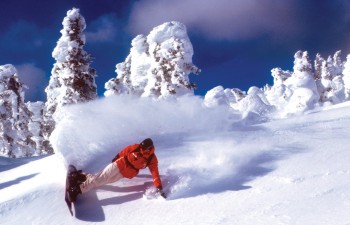More Canadian History
Kelowna, British Columbia, Canada
Kelowna, means "Grizzly Bear" in the native Salish tongue. Kelowna is the Okanagan's largest city and the Valley's first pioneer settlement, established in 1859. The Valley's fruit industry began here and still flourishes. Orchards, fruit processors and an orchard museum can be toured along with productive wineries. Another important early industry was cattle ranching. While both are still important in the region, industry and tourism has become increasingly important with a growing population.
The current 2002 population of Kelowna B.C. according to the census poll, is 100,433. The main industries are currently tourism, agriculture, wineries, and forestry. The elevation is 344 metres (1,129 ft.) above sea level. Several smaller communities surround Kelowna's main core. Winfield, Rutland, Glenmore, Glenrosa, Ellison, Westbank, Oyama, Lake Country, Lakeview Heights, Joe Rich, and Black Mountain. All of these communities combined bring the population base up to nearly 200,000. Kelowna is the fastest growing city in all of British Columbia. And among the fastest growing in Canada.
Kelowna
offers the amenities and conveniences of a larger destination but has all of the
charm and warmth of a smaller town. While situated right on the shores of
Okanagan Lake, other lakes, hills and accompanying recreational activities are
within a 15 minute drive of downtown. Kelowna is also home to the WHL (Western
Hockey League) team the Kelowna Rockets. Kelowna will host the WHL Memorial Cup
Finals in 2004. This event is expected to bring an estimated $15 Million worth
of revenue to Kelowna and the surrounding area.
![]()
Kelowna
is well known for its hot summers and temperate winters with an average daytime
high during July and August of 30.4°C. (87°F) The average daytime high during
December and January is -0.30°C. (32°F.) and the average low is -7.7°C. (19°F)
Kelowna receives over 2,000 hours of sunshine annually and just over 11 inches
of rain. Total annual precipitation is 280.7 mm. (11.06 inches) of rain and 60.5
cm. (23.81 inches) of overall snowfall.
Kelowna lies less than 35 miles from the northern tip of one of Canada's 3
official deserts. Sagebrush and some varieties of small cactus dot the landscape,
while rattlesnakes slither in the underbrush. The temperatures can be very
extreme, reaching 115 degrees F (+48C) (hot enough to fry an egg on the
sidewalk) in summer, to a bone chilling minus 30 degrees F (-35 C) in winter.
These are the vegetation, and animal types that live in our section of the
desert.
Flora in bloom -
Mugwort, common and green rabbitbrush, sagebrush, golden aster, white clematis,
snow buckwheat.
Fauna sighted - Praying mantis, yellow-bellied racer, Gopher snake,
Nuttall's Cottontail rabbit, Mule deer, coyote, Mountain Bluebird, Meadowlark,
Swainson's Hawk, Red-tailed hawk.
This region is home to a diverse array of uniquely adapted wildlife species such
the Nuttall’s
Cottontail, Great Basin Spadefoot Toad, Western Rattlesnake, Tiger Salamander
and Wind Scorpion,
to name a few. All of these are either blue or red listed, threatened or
endangered species.
For
more information about the Sonoran Desert in Osoyoos B.C. Canada,
click on the
link below.

Kelowna is also
less than 55 miles of a 2nd Canadian desert, which is located
near Kamloops B.C.
![]()
The main local attractions are, the Kelowna Museum & B.C. Orchard Industry and Wine Museum, Father Pandosy Mission, .. Fintry Queen Sternwheeler, .. Rotary Centre for the Arts, forestry tours, industrial tours, Winery Tours, .. Okanagan Lake Bridge (built in 1958) is North America's Longest Floating Bridge, .. Stuart Park on the Waterfront Promenade, Knox Mountain, Kasugai Gardens, Woodhaven Nature Conservatory, Kelowna Art Gallery, .. Kettle Valley Railway, and Skyreach Place (Hockey Arena, & Concert Stadium). Kelowna's biggest attraction is without a doubt Ogopogo. Ogopogo is a large aquatic reptile, 15 to 20 metres long, with a serpentine body (which forms a series of humps or loops when the animal is swimming at the surface), it has a long neck, with a horse-like head and two pairs of flippers which glide it through Okanagan Lake. It is believed that Ogopogo may be related to The Lock Ness Monster in Scotland. Millions of dollars have been spent by film companies trying to catch a glimpse of Kelowna's world famous sea-like creature.
To See OGOPOGO click on the photo below.
The earliest record
of Ogopogo's existence date back to 1860 and was ascribed as a ranting of the
first European settlers. That is sixty years before the first recorded reports
of The Loch Ness Monster. In
1926 some 30 carloads of people witnessed the event of the appearance of Ogopogo
at an Okanagan Mission Beach. Over the past 140 years there have been hundreds
of recorded sightings.
![]()
Kelowna boasts some of the best golf courses in
North America. Located in the rolling hills of the valley and overlooking the lake, the
Okanagan Valley has many picturesque golf courses to choose from. These courses will accommodate both the
casual, and dedicated golfer. With many months of ideal golfing weather each year the Okanagan offers the perfect choice for a
golf vacation.
Click on the map below to view the golf courses in the Okanagan Valley.

This is a map of the
golf courses in the Thompson-Okanagan region.
These 26 golf courses are all within a 2 1/2 hour drive of one another.
![]()
The Okanagan is also home to
a multitude of ski hills and resorts,
Click on the link below to view them all.

![]()
I hope you enjoyed your visit to Kelowna, B.C. Canada
the city that I call home.